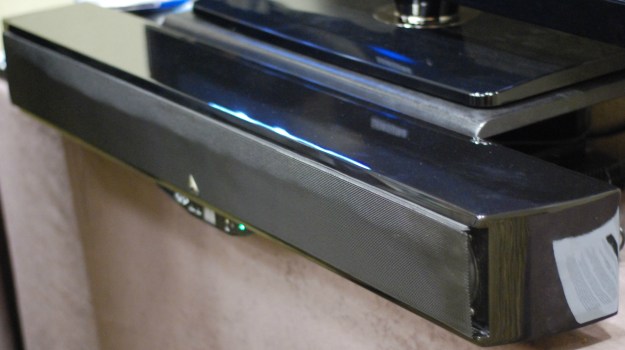
We rarely miss out on a chance to see Peter Tribeman at the CEDIA expo. The President and CEO of Atlantic Technology and Outlaw Audio is so full of charisma and passion for what he does, that he could probably do a presentation on the latest in toilet technology and people would crowd around to see it. Fortunately for the A/V world, Peter Tribeman isn’t in that line of work.
At CEDIA 2011, Atlantic Technology is demonstrating its latest effort, the 235 soundbar. If you’re thinking “not another soundbar!”, we won’t hold it against you. It is an unfortunate truth that the world has more soundbar options that it really needs. However, the 235 is postured as the first soundbar to be made that doesn’t need a subwoofer to produce impressive bass.
We found this an intriguing claim, which is the other reason we made certain to visit Atlantic Technology’s (AT) press-only demonstration. To be frank, AT’s claim that its “H-PAS” technology breaks all the rules of speaker making to allow deep bass from extremely small cabinets sounds a bit too familiar. We’ve read of several such “revolutions” from others before only to be severely disappointed by what we heard.
What we heard from the 235 today, though, was truly impressive — and not just because Tribeman was excited about it. Not only was the 235 unnervingly powerful in the bass department, it was remarkably clean and highly musical, too. And not just “for a soundbar”. The 235 sounded excellent for any speaker of its size and, indeed, better than speakers much larger.

The demonstration began with a Diana Krall cut that featured the singer’s vocals along with finger-snaps and well-recorded upright acoustic bass. Following that cut was a selection from a Kevin Mohagany record, then, for the movie fans, the opening sequence of The Day After Tomorrow. Each cut reproduced life-like vocals, deep bass and sparkling but controlled treble.
All of this excellent sound was reproduced in a rather large, acoustically unruly room from two 4-inch speakers and two 1-inch tweeters driven by a 2 x 40 watt amplifier. It is fair to say we were genuinely impressed.
The “magic” behind the 235’s excellent sound is the same H-PAS speaker cabinet design employed in AT’s AT-1 speaker, which has received its own fair share of positive reviews recently. In a nut-shell, the bass frequencies from the two 4-inch drivers are routed through several different chambers in the speaker cabinet, which pressurizes the bass and boosts it considerably. The approach, according to Tribeman, takes the heavy lifting of producing bass of the shoulders of the 4-inch drivers, thus allowing them to produce clean and realistic midrange and treble frequencies.
Tribeman says that the 235 is expected to cost around $500 to 600 and will be available under various badges from Atlantic Technology, H-PAS creator Phil Clements and Outlaw Audio but that it looks forward to licensing the technology to “other interested parties.”




